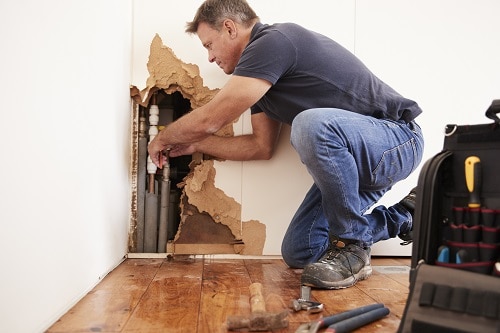Essential Steps for Effective Water Damage Reconstruction in your house
Water damages in your house can be a stressful incident that requires immediate focus and systematic restoration. When confronted with water damages, understanding the important steps to take can make a significant distinction in the end result of the reconstruction procedure. From determining the source of the damages to the final repair and reconstruction, each action plays a vital function in making sure the efficiency of the restoration initiatives. By complying with an organized technique, you can not just reduce the damage but additionally secure the health and honesty of your home (flooded basement albany ny).
Recognize the Water Damage Source

To determine the water damages resource, start by visually checking your property for any visible indications of water leakage or merging. Inspect locations prone to water damage such as basements, attics, and around plumbing fixtures.
In situations where the source of water damage is not promptly noticeable, seeking advice from a professional water damage remediation business can supply proficiency in locating and dealing with the underlying cause properly. Swiftly identifying and dealing with the water damage resource is essential in decreasing the level of damages and making sure an effective reconstruction procedure.

Get Rid Of Excess Water
To efficiently alleviate water damages in your home, prompt elimination of excess water is crucial to prevent more architectural harm and mold development. The first action in eliminating excess water is to determine the resource and quit the water from getting in the home.
When eliminating excess water, focus on security by guaranteeing that electricity is switched off in flooded locations to stop electric hazards. Additionally, use protective equipment such as handwear covers and boots to lessen contact with polluted water. Be comprehensive in the removal process, as even percentages of dampness left behind can bring about mold development and compromise the structural honesty of your home. By quickly getting rid of excess water, you can substantially reduce the degree of water damages and restore your home to its pre-damaged condition.
Dry Affected Locations
Trigger removal of excess water sets the foundation for the next essential action in water damage repair: drying the impacted locations completely. When the standing water has been drawn out, the Visit This Link emphasis changes to drying out the area totally to avoid additional damage and mold growth.

Furthermore, making use of specific devices like dampness meters can assist in recognizing hidden pockets of dampness within walls or floor covering, ensuring a comprehensive drying strategy. It is critical to keep track of the drying progress frequently to stop any type of setbacks or possible mold and mildew invasions.
In cases of substantial water damage, seeking specialist assistance from water damage repair professionals is advisable to make certain complete drying and protect against lasting structural concerns. Keep in mind, thorough drying out is key to effective water damage reconstruction and avoiding future complications.
Tidy and Disinfect
After drying out the affected areas, it is necessary to cleanse all surfaces with soap and water. Utilizing EPA-approved disinfectants can aid in reducing the effects of prospective wellness threats present in standing water or moisture-soaked materials.
When cleaning and disinfecting, it is important to use proper safety equipment such as handwear covers, masks, and goggles to secure yourself from any type of dangerous materials. Pay unique focus to locations that are commonly forgotten, such as surprise edges, wall tooth cavities, and under flooring, as they can harbor moisture and bacteria, leading to mold and mildew development and nasty odors if left unattended.
Repair Work and Restore Damaged Locations
After finishing the cleansing and disinfection procedure, the following critical action in water this page damages repair is to repair and restore the damaged locations in your home. As soon as the influenced locations have been extensively cleaned up and sanitized, it is necessary to evaluate the extent of the damages to determine what fixings you can look here are necessary. This might include repairing architectural damage, changing drywall, fixing flooring, or recovering damaged furniture and possessions.
It is important to resolve water damage without delay to avoid additional issues such as mold and mildew growth or architectural wear and tear. Hiring expert contractors or reconstruction specialists can make certain that repair work are done correctly and effectively. They have the experience and equipment to manage water damages remediation properly.
When repairing and bring back harmed areas, it is vital to make use of top quality materials that are immune to water damages to avoid future concerns. Additionally, making sure correct ventilation and wetness control in the recovered areas can help prevent mold and mildew development and maintain a healthy indoor environment. By attending to water damage immediately and effectively fixing and recovering harmed areas, you can guarantee the long-lasting security and honesty of your home.
Conclusion
Finally, effective water damages restoration in your home needs determining the resource of the damage, getting rid of excess water, drying out affected locations, cleansing and disinfecting, and fixing harmed locations. By adhering to these important steps, you can reduce the effect of water damages and recover your home to its pre-damaged problem. It is crucial to act promptly and thoroughly to avoid additional damage and guarantee a safe and healthy living environment.